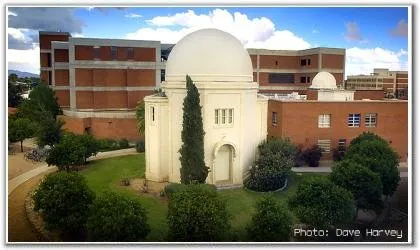Steward Observatory

The University of Arizona Steward Observatory and its associated academic division, the Department of Astronomy, form one of the finest centers for astronomical studies in the world.
Steward Observatory was officially established in 1916 through the foresight and perseverance of its first director, Andrew Ellicott Douglass, and a generous bequest made by Mrs. Lavinia Steward in memory of her late husband, Henry B. Steward. The Steward gift was used to build an observatory on an isolated tract of university land -- a former ostrich farm. Its construction, delayed by World War I, was finally dedicated in 1923. The 36" diameter Newtonian telescope was the first astronomical telescope to have been built using All-American made products.
By 1963, however, its once solitary setting -- ideal for stargazing -- had been encroached upon by an expanding Tucson, and the observatory's original telescope was removed from the dome and relocated to a darker mountain site on Kitt Peak. A smaller 20" Cassegrain telescope was installed in its place for student use. The original dome, a stately structure covered with cream colored tile, is a campus landmark and is listed on the National Register of Historic Places.
Astronomers here are among the national and international leaders in observational and theoretical research in astronomy. At the same time, they are making breakthroughs in related technology development -- from new light detectors to giant telescope mirrors -- that promise to be a catalyst for a renaissance in optical and infrared astronomy.
Steward Observatory scientists also have key roles in major space astronomy missions, including the Hubble Space Telescope and the Space Infrared Telescope Facility.
